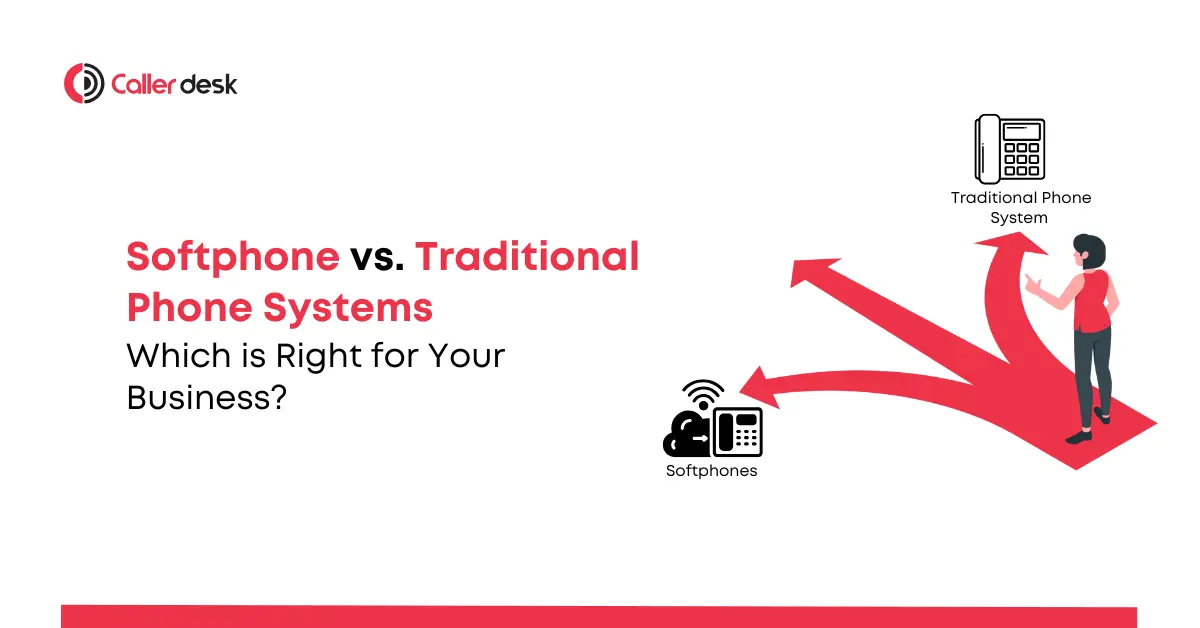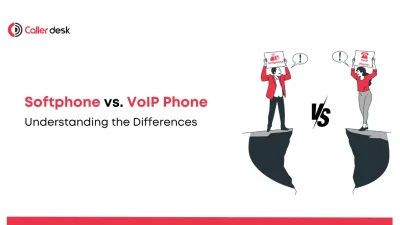Effective communication lies at the heart of every successful business. In an era where businesses are increasingly adopting remote work and hybrid setups, choosing the right phone system has become more crucial than ever. The choice often boils down to softphones and traditional phone systems, each with distinct benefits and limitations.
But how do you decide which system fits your business needs best? The right solution depends on your priorities—whether they’re cost savings, mobility, advanced features, or reliability. This guide will help you understand the key differences, pros and cons, and ideal use cases for both systems.
What Are Softphones?
A softphone is a software-based phone application that uses Voice over Internet Protocol (VoIP) technology to enable voice, video, and text communication over the internet. It can be installed on devices like laptops, smartphones, or tablets, allowing users to make calls without relying on physical desk phones or landlines.
Key Features of Softphones:
- Audio and Video Calls: Conduct high-quality voice and video communication.
- Team Messaging: Collaborate instantly through chat and file sharing.
- CRM Integration: Access customer information in real time during calls.
- Call Analytics: Track call performance and agent productivity.
Softphones are particularly well-suited for businesses looking for scalable, cost-effective, and feature-rich communication solutions.
What Are Traditional Phone Systems?
Traditional phone systems use landlines or Private Branch Exchange (PBX) systems for communication. These systems rely on physical infrastructure like copper wires and hardware-based servers to route calls.
Key Features of Traditional Phone Systems:
- Reliable Connectivity: Consistent performance, independent of internet connectivity.
- Basic Call Management: Voicemail, call forwarding, and conferencing capabilities.
- On-Premise Setup: Requires hardware installation and maintenance.
While traditional systems have been a staple of business communication for decades, they often lack the flexibility and modern tools that today’s dynamic work environments demand.
Softphones vs. Traditional Phone Systems: A Detailed Comparison
1. Technology and Infrastructure
- Softphones: Operate entirely on the internet, eliminating the need for complex physical setups. No additional wiring or hardware is required.
- Traditional Phones: Depend on extensive physical infrastructure, including landlines and PBX systems, which require on-site installation and maintenance.
2. Setup and Maintenance
- Softphones: Easy to install and maintain. Simply download the software, configure the settings, and start calling. Updates are automatic, requiring minimal technical intervention.
- Traditional Phones: Involve a lengthy setup process, including wiring and hardware installation. Maintenance can be costly and time-intensive.
3. Cost Structure
- Softphones: Offer significant cost savings. They eliminate the need for expensive hardware and reduce international call rates. Businesses can choose scalable plans, paying only for what they use.
- Traditional Phones: Require a substantial upfront investment for equipment, followed by recurring costs for maintenance and upgrades.
4. Mobility
- Softphones: Enable users to make and receive calls from any location with an internet connection. Ideal for remote teams, hybrid work models, and employees on the go.
- Traditional Phones: Limited to fixed locations, making them unsuitable for businesses with remote or mobile workforces.
5. Features and Functionality
- Softphones: Packed with advanced features like video conferencing, real-time messaging, call recording, file sharing, and CRM integration, enabling better collaboration and efficiency.
- Traditional Phones: Provide basic calling features such as voicemail and conference calling, but lack the advanced tools needed for modern business communication.
6. Security and Compliance
- Softphones: Depend on robust encryption protocols and cybersecurity measures to ensure data protection. Choosing a trusted provider like CallerDesk ensures compliance with global standards like GDPR and SOC 2.
- Traditional Phones: Offer built-in security due to their physical nature, but they’re limited in protecting sensitive data shared during calls.
Pros and Cons of Softphones
Pros:
- Affordable: No need for physical hardware or complex installations.
- Scalable: Easily add or remove users as your business grows.
- Feature-Rich: Advanced tools like video calls, messaging, and integrations with business software.
- Remote Work Friendly: Perfect for teams working from home or multiple locations.
Cons:
- Internet Dependency: Performance depends on network stability.
- Learning Curve: Employees may need training to use advanced features effectively.
- Security Concerns: VoIP systems are prone to cyber threats without proper safeguards.
Pros and Cons of Traditional Phone Systems
Pros:
- Reliable: Not affected by internet disruptions.
- User-Friendly: Familiar and simple to use, especially for non-tech-savvy employees.
- Independent of Internet: Ideal for locations with unreliable internet access.
Cons:
- Expensive: High costs for installation, maintenance, and upgrades.
- Inflexible: Limited to fixed office locations, lacking mobility.
- Basic Features: Doesn’t support modern tools like video conferencing or CRM integration.
Which One Is Right for Your Business?
The decision between softphones and traditional phone systems depends on your unique business needs:
Choose Softphones If:
- Your business has a remote or hybrid workforce.
- You want advanced features like video conferencing, team messaging, and real-time analytics.
- Scalability and cost savings are top priorities.
Choose Traditional Phones If:
- Your business operates in areas with limited internet connectivity.
- You prefer a simple, reliable solution without additional features.
- Your employees are already familiar with landline systems and don’t require modern tools.
Why CallerDesk Softphones Are the Best Choice
CallerDesk’s softphone solutions are tailored to meet the demands of modern businesses. Here’s why they stand out:
- Feature-Rich: Includes advanced tools like call analytics, CRM integration, and video conferencing.
- Optimized for Indian Networks: Designed to handle challenges like uneven internet quality, ensuring smooth communication.
- Robust Security: End-to-end encryption and compliance with international standards for data protection.
- Scalable Plans: Affordable options for businesses of all sizes, with the ability to add or remove features as needed.
- Dedicated Support: 24/7 assistance to ensure seamless adoption and operation.
Conclusion
Softphones and traditional phone systems each serve unique purposes. While softphones excel in flexibility, cost efficiency, and modern features, traditional systems provide reliability and simplicity in locations with poor internet access.
By choosing CallerDesk softphones, your business gains access to cutting-edge communication tools that empower teams, improve productivity, and enhance customer experiences. Whether you’re managing a remote workforce or scaling operations, softphones are the future of business communication.
Contact CallerDesk today for a free demo and discover how our softphone solutions can transform your business!
Frequently Asked Questions
1. What is the main difference between softphones and traditional phone systems?
Softphones are software-based solutions that use the internet to make and receive calls, while traditional phone systems rely on physical phone lines and hardware like landlines or PBX systems. Softphones offer greater flexibility and advanced features, whereas traditional systems provide reliable connectivity without internet dependency.
2. Are softphones suitable for small businesses?
Yes, softphones are ideal for small businesses because they are cost-effective, scalable, and require no expensive hardware. They are especially beneficial for businesses with remote or hybrid teams, allowing employees to stay connected from anywhere.
3. What are the key benefits of using softphones for businesses?
Softphones provide:
Cost savings by eliminating hardware and reducing call costs.
Advanced features like video calls, team messaging, and CRM integration.
Mobility and flexibility for remote or hybrid work setups.
Scalability to add or remove users as the business grows.
4. Can softphones replace traditional phone systems entirely?
Softphones can replace traditional systems for many businesses, especially those with reliable internet access and a need for advanced communication features. However, businesses in areas with poor internet connectivity or those prioritizing simplicity and reliability may still prefer traditional phone systems.
5. What are the primary challenges of using softphones?
The main challenges include:
Dependence on internet connectivity, which may affect call quality.
Potential security risks if proper safeguards aren’t in place.
A learning curve for employees unfamiliar with VoIP technology.
6. How secure are softphones compared to traditional phone systems?
Softphones can be very secure if proper measures are taken, such as end-to-end encryption, firewalls, and regular software updates. Traditional phone systems are less prone to cyberattacks due to their offline nature but may not protect sensitive data as effectively as secured VoIP systems.
7. How do softphones integrate with other business tools?
Softphones seamlessly integrate with tools like CRMs (e.g., Salesforce, HubSpot), project management apps, and email platforms. This enables agents to access customer data during calls, log interactions, and streamline workflows.
8. Are traditional phone systems outdated?
Traditional phone systems are not outdated but are becoming less suitable for modern businesses that require advanced features, mobility, and scalability. They still serve businesses that prioritize simplicity and operate in areas with limited internet connectivity.
9. How can businesses decide between softphones and traditional phone systems?
Businesses should evaluate factors like:
Internet reliability in their location.
Need for advanced features like video conferencing and integrations.
Budget constraints for setup and maintenance.
Team structure (remote, hybrid, or in-office).
10. Why should I choose CallerDesk softphones for my business?
CallerDesk softphones offer:
Seamless integration with CRMs and other business tools.
Advanced features like call analytics, video conferencing, and file sharing.
Reliable performance optimized for Indian networks.
End-to-end encryption and compliance with global data security standards.
Affordable, scalable solutions for businesses of all sizes.
11. Can softphones support international calls?
Yes, softphones are an excellent choice for international calls. They use VoIP technology to significantly reduce international calling costs while maintaining high call quality.
12. How do softphones handle call quality issues?
Softphones use advanced VoIP protocols to optimize call quality. Businesses can improve performance by ensuring a stable internet connection, prioritizing VoIP traffic, and using high-quality microphones and headsets.





